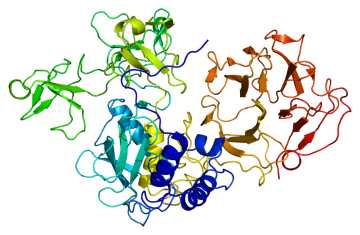
Young frog with tail. Source: flickr.com
 By Georgina Butler, Research Associate at Overall Lab, CBR
By Georgina Butler, Research Associate at Overall Lab, CBR
In 1962 when Gross and Lapiere wondered what was responsible for the disappearance of a tadpole’s tail, they discovered collagenase – an enzyme responsible for degrading collagen. Following this, structurally similar enzymes were found that acted on collagens and other extracellular matrix proteins – they became known as the matrix metalloproteinase (MMP) family and the dogma was born: “MMPs are collectively responsible for degrading all components of the extracellular matrix”. Research was hypothesis driven and governed by this dogma – each time a new member of the family was found, different extracellular molecules were examined for cleavage. This inspired the development of drugs: In the 1980s, pharmaceutical companies invested millions of dollars targeting MMPs with inhibitors for cancer therapy. Since the spread of the primary tumour to secondary sites (i.e. metastasis) is facilitated by MMPs, which degrade the extracellular matrix enabling release of the tumour into the blood stream, blocking this process was anticipated to slow-down the disease. However, these first generation clinical trials failed due to side effects and limited efficacy – MMPs as anti-cancer therapeutics fell from grace.
Previously, researchers had little choice but to build upon the paradigm, therefore performing studies in a limited sphere. Pathways, such as complement and coagulation, were conveniently compartmentalised into their own boxes – thus, information was compiled on how these pathways function in isolation, but information on how they interact in the bigger arena, our bodies, was not yet accessible. The Conway lab in the CBR is currently connecting these boxes by investigating crosstalk between these two proteolytic cascades.

Matrix metallopeptidase 2. Source: Wikipedia
Thanks to proteomics technologies we now also have a wealth of unbiased data at our fingertips. For example, the Overall lab, in a subfield of proteomics, known as degradomics, is addressing the question of “which proteins are processed by a particular MMP in this sample?” Not only is a list obtained of all the proteins cleaved by that MMP in the sample (e.g. a human tissue extract) but also the site(s) where each protein has been cut. Thus, we now know that rather than being merely degraders of extracellular matrix, MMPs modulate the function of a plethora of different proteins, including chemokines, binding proteins, receptors, and inflammatory mediators to not only inactivate them, but also activate, alter bioactivity and even invoke novel activities. The various MMPs process distinct subsets of proteins, thus targeting all twenty-three human MMPs with pan-specific inhibitors blocks processing of not just extracellular matrix molecules, but all substrates. This prevents beneficial, as well as detrimental activities and explains why the first generation MMP-targeted therapeutics were not successful.
Due to its broad scope, one might consider that proteomics has encouraged thinking outside of the box. I would argue that this technology has simply enlarged the box. The lists of proteins that are generated by proteomics experiments are generally huge and require multiple approaches to identify the most likely candidates. This is partly achieved by imposing strict statistical cut-offs. However, the resulting lists of candidates may still be subject to interpretation and hampered by dogma.
For example, MMPs are extracellular (or plasma membrane-tethered), so why bother considering proteins in lists of candidate MMP substrates that are annotated as intracellular or DNA binding? Similarly, proteins that have no secretory signal peptide must be artefacts of sample preparation, right? It turns out that comparing MMP-exposed to MMP-null samples implicates a subset of these “intracellular” proteins as MMP substrates.
Poking a small hole in the side of the “box” and reading about these proteins revealed that some escape during necrosis, or are secreted in a regulated manner by alternative secretion pathways, such as exosomes. Excitingly, some of these “artefacts” are key players in autoimmunity and inflammation, such as during sepsis, and therefore, their activities could conceivably be regulated during pathogenesis by MMP processing.
Discounting proteins found by proteomics based on dogma or “what we think we know” is a convenient way of shortening the candidate list but it also confines us within this new, larger box. Let’s break out of that box, leave dogma and “what is known” behind, and have the courage to look at the unexpected. This is where the breakthroughs are waiting: not where people have been looking for decades but where no one has thought to look yet.


